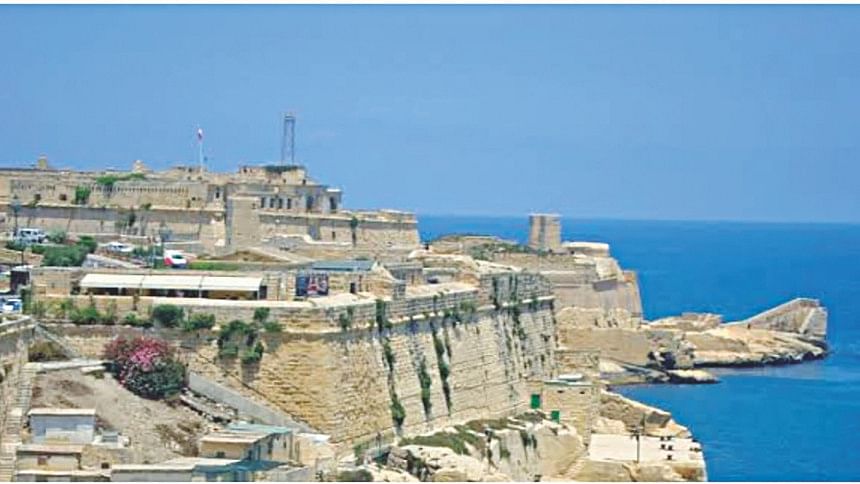Malta: Room to Roam (Part I)

"Wordsworth's poetry attracted tourists to the places that had inspired it...By 1845, it was estimated that there were more tourists in the Lake District than sheep."
-Alain De Botton, The Art of Travel (2002)
"Room to roam" remains my indelible imprint of this idyllic historical island. A less trodden route. A lesser known travel-worthy spot. Here lies an under the radar gem of an isle far from madding hordes. Bella vistas while beating the crowds during the peak summer travel month of July. For any discerning travel bug, Malta in a maiden visit provides a rare feeling of transformational travel whilst exploring an open-air museum under an azure sky where heaven and earth meet. Origins of the past and the present offer stories of the ages. Legacy meets legend. Its wide array of iconic architectural structures, diverse landscape, coastal and natural gems, serpentine weaving lanes result in a serene and unsung island oasis. On offer are remnants of a multi-layered patrimony yet vivid offerings of contemporary living. Valletta, the capital is a combination of natural grandeur and easy blend of history with modernity; stylish yet low-key. If there is any such thing as "the glamour of history"; Malta has it all. Both hip and historic.
Often a destination, long-imagined and desired, turns out to be deficient in its fulfillment. Somewhat not up to the mark as reckoned, that sought for or hoped for. Such awakenings can be gleaned from art, books, films, people, places, photographs and importantly the wide spectrum of childhood memories. Inspiration can originate from anywhere. The island of Malta floating below the Italian island of Sicily, beyond the boot of Italy has been a childhood desire destination; largely built in association with early European history lessons. Remembrance of things past. Strains of romantic notions of knights in shining armour and damsels in distress are core childhood images associated with Malta. Early in the sixteenth century, the king of Spain handed Malta over to The Knights of St. John, featuring frequently as European Crusader knights en route to Jerusalem. The Catholic Military and Hospitaller Order ruled the island for some two hundred and sixty-eight years. The Knights claimed transforming what they called "merely a rock of soft substance" into a flourishing island with forts, churches, and the founding of Valletta; "Superbissima" (Most Proud) among the European powers. Today, maturity exposes reality over fantasy. Christianity, commerce and civilisation were push factors. Inquisition religious courts took care of all political, ethnic and religious opposition. Founded in the twelfth century in Europe by Pope Lucius III for the persecution of non-Catholic Christians; the Vatican enforced all its might of jurisdiction - in the name of Roman Catholicism.Over time, it was extended to Muslims and Jews. The Crusades evolved into a battle of the Crescent versus the Cross.
In Seville, Spain is to be found a museum dedicated to torture. Venice offers one. Not to be out-done, Malta offers its very own Inquisitor's Palace on its island Birgu. Mind you, these did not figure anywhere close to my must-see sites.With our travel itinerary listing Rome, Venice and Milan in Italy, a glance at an atlas map (yes, I still use them!) I noted that Valletta, Malta's capital city had been awarded by UNESCO World Heritage Site, the prestigious title "European Capital of Culture 2018." A choice was thus made to include Malta. The Canadian writer David Baird (1956-) cautions us: "Don't rely on others to show you the way, carry your own map."
While following the trail of paths less travelled today; I have always known that since long; long waves of armies and settlers - the Arabs, British, Byzantines, Crusaders, French, Greeks, Ottomans, Phoenicians, Romans, Sicilians, Spaniards, Venetians, World War 1 and World War 11 participatory parties; including the Allies, Fascists and Nazis have all crisscrossed at different periods in history this geo-strategic island. During the two World Wars of the twentieth century, Malta's salubrious climate and surroundings earned it the title "Nurse of the World." All parties navigated the high seas while anchoring at the cross-road stop-over between Europe and the Middle East.Sea-faring trading powers from the fourteenth through the twentieth century attracted maritime incursions by states and empires from A to Z; evolving into a melting pot of humanity while establishing a multifarious emporium. Centuries-old tussles have featured to control this tiny dot in the Mediterranean Sea; in successive cycles of war and peace.
Orhan Pamuk offers us his take in Other Colours: Writings on Life, Art, Books and Cities (2007). "For the Ottomans, the Mediterranean was a geographical entity: a body of water, a string of routes, straits, and passageways...this inland sea was fraught with danger. It was home to Venetian galleons, Maltese ships, corsairs, storms of uncertain origin and disasters." Today Malta's cobblestone streets march to the beat of a gentler drum yet history seeps into you. Despite becoming an independent state in 1964, the last foreign occupants, the British only left the island in 1979. The island was a British Crown Colony since 1813; a strategic stepping-stone for its expansion to the East.Malta joined the European Union in 2004.
Our room with a view in the Sleima neighbourhoodwas a "bolt from the blue," an endless frame where the sky meets the sea. Goethe in 1810 in his Theory of Colours remarked: "We love to contemplate blue, not because it advances to us, but because it draws us after it." And there atop the rounded boulders bordering the craggy shoreline were early risers and sun-setting "golden hour" yoga practitioners. In between, scores soaking up the sun under a cloudless blue span. A two kilometer-long promenade hugs the rocky coastline. Here and there rock-cut natural pools of seawater remain naturally refreshed by the ebb and flow of waves. An efficient public bus transport and road infrastructure system provide us with the opportunity to explore the island. Such urban escapes offer eye-popping views of nature's comfort and allure. Olive trees flourish with relish. Sculpted grotto fountains sprout uninterrupted. Citrus groves emanate essence. Orchards remain evidence of bountiful seasonal fruits. Thick boxwood hedges demarcate the rocky terrain here and pastureland there. Myriads of oleander blooms, soaring pine and majestic cypress trees intermingle.Untamed boughs of bougainvilleas provide a riotous palette of Mother Nature's colour spectrum. And never have I come across such an abundance of clumps of diverse cacti plants growing wild. Just maybe, Moslih Eddin Saadi, the Persian poet would include me when he remarked: "A traveller without observation is a bird without wings."
Ancient hilltop settlements beckon with curvilinear lanes housing village houses painted in warm earthy colours; some featuring hillside hotels; its streets manifestation of walkways of art. The motto in mind: "The flaneur - that aimless stroller who loses himself in the crowd, who has no destination and goes wherever caprice or curiosity directs his steps." (Edmund White, The Flaneur 2001). Meandering through mazes of streets leads us to Valletta's water-front where pedestrians pause beside the sea-rocks or taking a turn, turn up in a cobble-stoned plaza, often positioned with a commanding church and a central bubbling fountain. Adults and parents linger over an espresso, cappuccino or a sea-food meal or enter artisanal boutiques.Care-free children run around the open space. Go-slow cafes, bustling bars, bistros, gelato vans, restaurants, tavernas- all inviting destinations that also provide a locale for people-watching. Unforgettable is the tucked away "Lebanese Kebab & Grill" on Falafel Street, a fast food outlet offering shawarma and falafel to be savoured along with olive-oil coated bowls of hummus and fragrant green tabouleh; invoking sensory culinary memories of Beirut. How does one forget a board that proclaims: "Why have abs when you can have kebabs!"
Advised by a hotel staff member to visit a nearby fishing village, accessible by bus. We took her advice and in a cliché picture perfect postcard scenario were seated along a curving Mediterranean coastline. We were tucking into an al fresco lunch beside a quartet of Maltese women. Over the succulent grilled fresh fish, velvety mashed potatoes and olive oil drenched tomato and mozarrella cheese salad and a plate of pasta coated in a zesty tomato sauce - all fresh fish and farm produce to table - we chit-chatted with our neighbours. Once a month, the four friends meet at this family-run small sea-side location for lunch. They assured us that we had partaken the best value for money meal in Malta. And all this for the princely sum of Euros15 per head. We skipped the rabbit selection, the national delicacy. A stiff double espresso completed our Mediterranean feasting. Heading back to the bus-stop, we stopped by a mother and daughter run stall purchasing packets of sun-dried tomatoes, anchovies, capers, olives, pasta, pimento and a kitsch quirky kitchen towel. Sensory and therapeutic moments to relish and relive.
As one of Europe's most Catholic countries, the Maltese islands boast the highest density of churches per square kilometer. One sightseeing article refers to "church-crawling in Malta is of a high order."Mdina is the old capital city established by the Knights of Malta; a medieval walled city establishing ecclesiastical authority via the Vatican's sphere of influence. Mdina (taking its name from the Arabic word for "city") was Malta's capital for centuries before Valletta was built. Entering the enclosed entity, we found time and tourists distant as we strolled through empty labyrinthine alleys and piazzas. Ornate basilicas beckon. Entering imposing cathedrals, we come upon gold mosaics and thick marble columns holding up a roof-scape that mirrors the sky in its grandeur; a totality of fragility and finesse. In the midst of sounds of silence while seated in the pew, came to mind the reflective remark by Charles de Gaulle in an interview he gave to Newsweek magazine in 1962. "Hearing Mass is the ceremony I most favor during my travels. Church is the only place where someone speaks to me...and I do not have to answer back." Heading out of Mdina, we linger before a Baroque engraving "Tales of the Silent City."
Raana Haider is a travel writer.

 For all latest news, follow The Daily Star's Google News channel.
For all latest news, follow The Daily Star's Google News channel. 



Comments